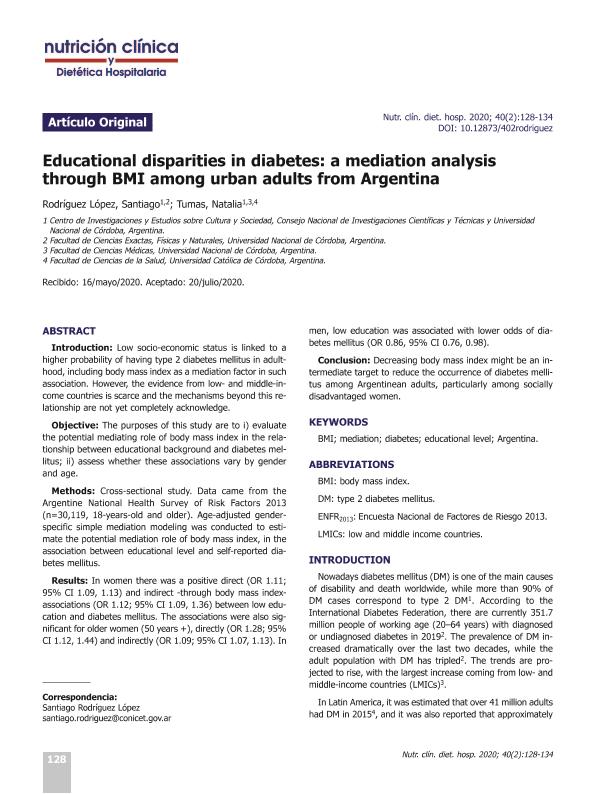Artículo
Educational disparities in diabetes: A mediation analysis through BMI among urban adults from Argentina
Fecha de publicación:
08/2020
Editorial:
Sociedad Española de Dietética y Ciencias de la Alimentación
Revista:
Nutrición clínica y dietética hospitalaria
ISSN:
0211-6057
e-ISSN:
1989-208X
Idioma:
Inglés
Tipo de recurso:
Artículo publicado
Clasificación temática:
Resumen
Low socio-economic status is linked to a higher probability of having type 2 diabetes mellitus in adulthood, including body mass index as a mediation factor in such association. However, the evidence from low- and middle-income countries is scarce and the mechanisms beyond this relationship are not yet completely acknowledge. Objective: The purposes of this study are to i) evaluate the potential mediating role of body mass index in the relationship between educational background and diabetes mellitus; ii) assess whether these associations vary by gender and age. Methods: Cross-sectional study. Data came from the Argentine National Health Survey of Risk Factors 2013 (n=30,119, 18-years-old and older). Age-adjusted genderspecific simple mediation modeling was conducted to estimate the potential mediation role of body mass index, in the association between educational level and self-reported diabetes mellitus. Results: In women there was a positive direct (OR 1.11; 95% CI 1.09, 1.13) and indirect -through body mass indexassociations (OR 1.12; 95% CI 1.09, 1.36) between low education and diabetes mellitus. The associations were also significant for older women (50 years +), directly (OR 1.28; 95% CI 1.12, 1.44) and indirectly (OR 1.09; 95% CI 1.07, 1.13). In men, low education was associated with lower odds of diabetes mellitus (OR 0.86, 95% CI 0.76, 0.98). Conclusion: Decreasing body mass index might be an intermediate target to reduce the occurrence of diabetes mellitus among Argentinean adults, particularly among socially disadvantaged women.
Palabras clave:
BMI
,
MEDIATION
,
DIABETES
,
EDUCATIONAL LEVEL
,
ARGENTINA
Archivos asociados
Licencia
Identificadores
Colecciones
Articulos(CIECS)
Articulos de CENTRO DE INVESTIGACIONES Y ESTUDIO SOBRE CULTURA Y SOCIEDAD
Articulos de CENTRO DE INVESTIGACIONES Y ESTUDIO SOBRE CULTURA Y SOCIEDAD
Citación
Rodríguez López, Santiago; Tumas, Natalia; Educational disparities in diabetes: A mediation analysis through BMI among urban adults from Argentina; Sociedad Española de Dietética y Ciencias de la Alimentación; Nutrición clínica y dietética hospitalaria; 40; 2; 8-2020; 128-134
Compartir
Altmétricas




